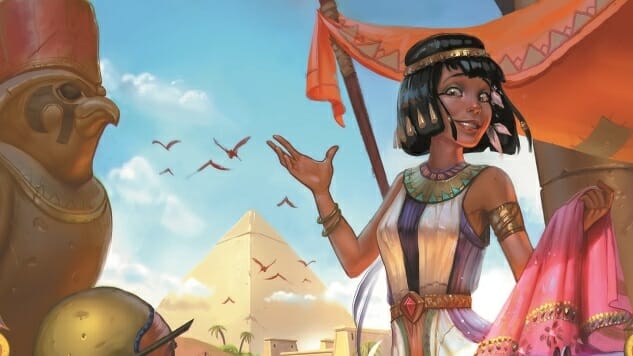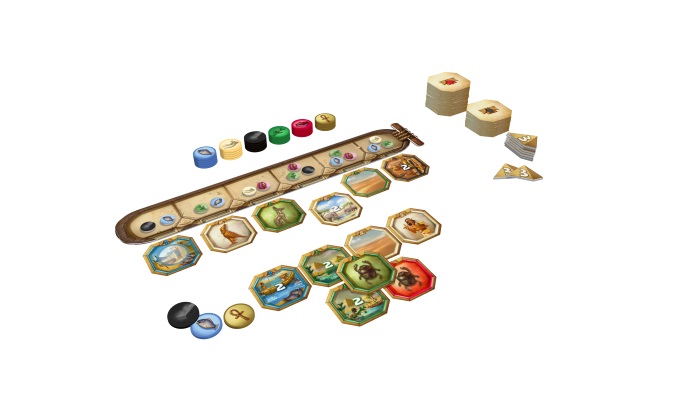
Ankh’or is the second title in the Space Cowboys imprint’s line of small box games, after their reissue of the two-player classic Jaipur—still my #1 two-player game of all time. This game plays two to four, but it works extremely well as a two-player experience, and I think it’s a sneaky-good game for younger players who lack the reading skills for more complex games but are otherwise ready to level up from kids’ titles.
Ankh’or is a tile-laying game with a heavy dose of Splendor along the way. You take tokens in six different colors, taking three at a time on any turn where you take coins, and then use them in later turns to buy any of the six tiles from the display. All tiles have a color, and most show an animal, although there are a few other special types. You lay those tiles on the table in front of you and try to create contiguous, matching groups of tiles that correspond by color (five different ones) or by animal (three—a jackal, a beetle, and a scarab). At game-end, you score one point per tile in any contiguous group of two or more, but you can get a three-point bonus token any time during the game if you make a group of five by color or animal. Special tiles include scribes, which grant you an immediate bonus turn; warehouses, which let you take one extra token of the tile’s color and store it on that tile, even if you exceed the five-token limit by doing so; two-point tiles; and desert tiles, which have a color but no other function.
The one new-ish mechanic in Ankh’or is the tile market itself. The game comes with a market bar that has 15 holes in it; at the start of each game, you randomly distribute the 15 colored cardboard circles, three of each of the game’s five tile colors, across those holes, with the three leftmost tiles costing two tokens each and the three rightmost tiles costing three tokens each. (In the unlikely event that you end up with a random pull that makes a tile cost three tokens of the same color, you redistribute those pegs.)

Here’s the trick: When someone buys a tile, you don’t fill the vacate space. The sixth color of token is orange, the ankh tokens, and those aren’t used at all for buying tiles. They serve two other functions, the more important of which is that you play an ankh as a free action on a turn to reset the tile market. You discard the leftmost tile if you have just two players, slide all remaining tiles to the left, and then fill to the right from the supply. Timing this move is a huge part of strategy in Ankh’or, moving tiles to places where you can buy them more easily, or trying to stick your opponent with tiles that don’t help them, or even moving a tile an opponent might be about to buy to another space for which they lack the right tokens. It’s a subtle but critical “take that” mechanic that utterly makes the game. Without it, it’s too easy to turn this into solitaire where you just try to avoid buying the same tiles your opponents might buy. The other function of ankh tokens is to move one tile you’ve already placed to another spot on your tableau, although it’s much less useful.
Although the box suggests the game is for kids 10 and up, there’s really no reason younger kids can’t play this game. There’s no reading required, nothing more than color/image matching and simple arithmetic. I played it with a six-year-old who caught on to everything except for the “take that” part—she picked up on the value of using the ankh tokens to reset the market to let her add tiles that might help her more, or to move certain tiles to the left. So you can make it a family game if the older players are mindful not to be to harsh with the youngest ones.
The components are quite high-quality, especially for a small-box game with a price point under $25; the pegs used to set the prices on the market bar are a bit small, but I haven’t lost one yet. With Jaipur and Ankh’or already on the market and the upcoming Tea for Two, the Space Cowboys small-box line is off to a roaring start.
Keith Law is a senior baseball writer for ESPN.com and an analyst on ESPN’s Baseball Tonight. You can read his baseball content at search.espn.go.com/keith-law and his personal blog the dish, covering games, literature, and more, at meadowparty.com/blog.